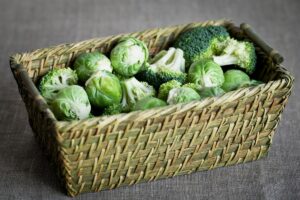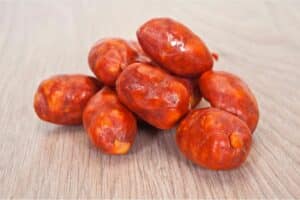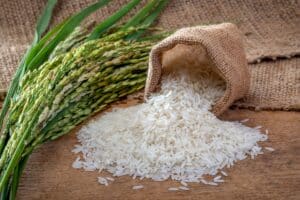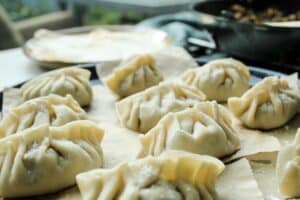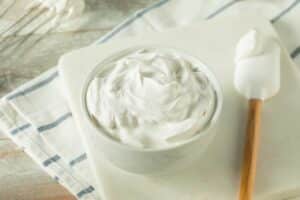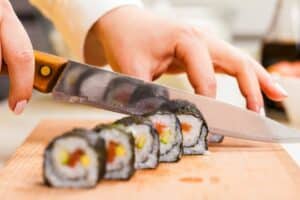Garlic is an allium native to Asia and part of the same family tree that includes scallions, onions, shallots, leeks, and chives. Even though garlic is produced predominantly in China for seasoning and condiments, it’s become a staple in kitchens worldwide, used in culinary traditions from Italy to Spain.
Despite fresh garlic being healthier than the dried or processed versions, garlic has been used by mankind ever since the ancient Egyptians for its antibacterial properties.
In this article, we’ll be discussing the difference between garlic powder and granulated garlic. So keep reading if you’re questioning: is granulated garlic the same as garlic powder?
Granulated Garlic vs. Garlic Powder
The main difference between granulated garlic and garlic powder is the texture and the size of the granules. Granulated garlic is coarse, whereas garlic powder is super fine, similar to the texture of cake flour.
Ultimately, it comes down to personal preference, and what you’re going to be most often using garlic for while cooking. However, they can be used interchangeably with specific measurements that will be elaborated on below.
- Flavor and smell
- Garlic powder is low-odor.
- Roasted garlic powder is more golden-yellow with a bigger bite, stronger aroma, and a more potent flavor.
- Garlic powder should be hydrated to release full flavor potential, which is concentrated and pungent.
- Granulated garlic brings out the flavor of a dish and is sharper than other types of garlic. Avoid using too much by adding flavor in smaller quantities.
- Shelf life
- Garlic powder is shelf-stable but has a shorter shelf-life compared to granulated garlic.
- They can both last for several months in a cool, dark environment and not turn rancid like fresh garlic.
- Texture
- As previously mentioned, garlic powder is fine, so it dissolves quickly and easily. It won’t scald, burn, or become bitter while you add it to your dish.
- Its texture allows for a final dish that’s evenly seasoned without taking away from the consistency.
- Appearance
- Garlic powder is made from real, dehydrated garlic. The garlic bulbs are cleaned to remove the protective skin, then dried and milled to the company’s fineness specifications.
- Granulated garlic follows a similar path. The garlic is peeled and minced, then placed in slow-drying ovens. These pieces are sold as flakes, but they can be ground more to achieve the granules or fine powder. If roasted, the flavor changes from mellow to nutty. The color becomes noticeably yellow as well.
Comparison Table Between Granulated Garlic and Garlic Powder
| Granulated Garlic | Garlic Powder |
| More expensive than garlic powder. | Effortless, cost-efficient. |
| 1 Tbsp | ½ Tbsp (Use a smaller amount if substituting due to potent flavor, don’t want to ruin your dish with too much garlic). |
| Changes texture of rubs or marinades, chunkier. | No texture changes. |
| Can be difficult to find at grocery stores unless you make it yourself. | More readily available at markets. |
Can You Substitute Granulated Garlic for Garlic Powder?
Generally, ¼ teaspoon garlic powder is equivalent to one clove of garlic. Garlic is available in countless forms, and there’s no harm in substituting one for the other.
However, garlic powder is more intense in flavor because of its texture and small granule size; when exposed to oxygen, it releases the sulfur compound, making the taste stronger.
A variety of dishes use garlic for various purposes. Since granulated garlic and garlic powder are relatively similar, you can easily switch out granulated garlic for powder. But, keep the measurements above in mind.
Otherwise, there are alternative options for you to choose from if you don’t have either on hand. Granulated garlic can be substituted with garlic powder, as established, garlic salt, garlic juice, or garlic flakes.
Garlic salt can be used in place of garlic granules. One teaspoon garlic salt is equal to ¼ teaspoon garlic granules. If you choose to use garlic salt, remember to avoid adding extra salt to your recipe.
Garlic juice is extracted from fresh garlic. One teaspoon of garlic granules is equal to ½ teaspoon of garlic juice. Remember that since garlic juice is a liquid, it could alter the texture of your soup or sauce, depending on how much you add.
Finally, garlic flakes are the most accurate substitution. You should double the number of garlic flakes you use.
For example, one teaspoon of garlic granules equates to two teaspoons of garlic flakes. Furthermore, if you soak the flakes in water, they can replace fresh garlic.
Use the one that best suits your taste profile and recipe. It’s recommended to keep onion powder or shallots on the side as a backup plan. These alternatives achieve a similar flavor profile.
What is Granulated Garlic?
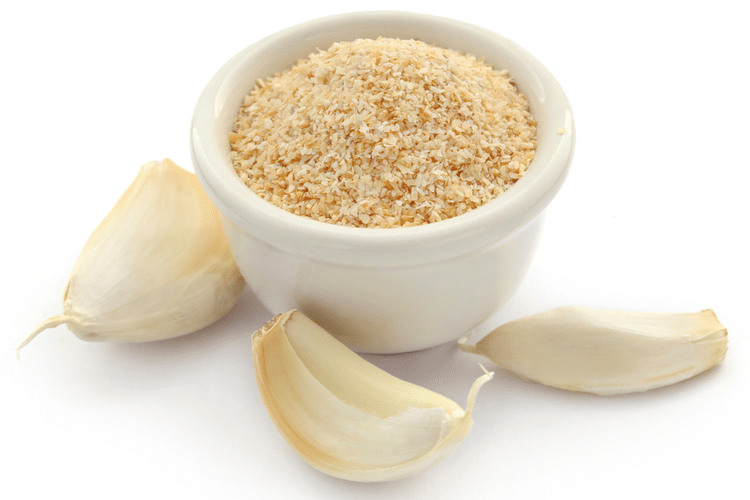
Garlic is one of the oldest known crops. Records of garlic date back to being grown in China about 4,000 years ago.
While at this moment in time, wild garlic only grows in Central Asia, it grew in a much larger area years ago, spreading across India to Egypt to Ukraine.
Garlic is widely grown for markets by many cultivators. The U.S. produces large quantities as well.
Did you know that about 10 million metric tons of garlic are produced globally each year? Despite this, garlic has only been recognized as a domestic crop or having routine seed production since the 1980s.
There are many varieties of garlic and can be divided into two groups with various subcategories. Garlic has hardneck or softneck varieties. These include:
- Porcelain
- Rocambole
- Purple Stripe
- Glazed Purple Stripe
- Marbled Purple Stripe
- Asiatic
- Turban
- Creole
- Silverskin
- Artichoke
- Middle Eastern
Garlic cultivation throughout history has only been propagated via vegetable cloves or bulbs, and not from seed.
In summary, granulated garlic is simply fresh garlic that was peeled, minced, and put in a slow-drying oven. You can make it yourself by chopping up garlic and following the established process.
Then to achieve powder, you would grind those flakes down further. Garlic is intensely popular, especially after combining it with other herbs and spices to make your meals flavorful and memorable.
How to Use Granulated Garlic
When adding granulated garlic to a recipe, remember the motto less is more. Use about half the amount you are expected to use with fresh garlic because it has a stronger flavor.
You can use granulated garlic pretty much however you would use regular garlic, just with less. So, that could be in whatever culinary, savory delights you concoct in your kitchen for lunch or dinner.
A few ideas would be to sprinkle granulated garlic over pizza or stir some into a chowder. Garlic goes along with ribs in a dry rub or a rotisserie chicken.
A perk about granulated garlic, as opposed to fresh garlic, is that if stored properly, the dried version can last years with a more concentrated and potent taste than its fresh counterpart. Overall, granulated garlic is ideal for soups and sauces because it dissolves quickly in hot liquid.
What is Garlic Powder?
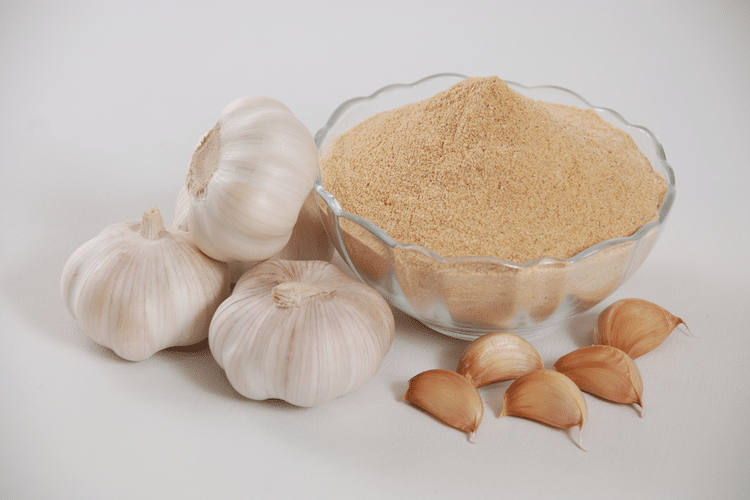
Garlic powder is akin to granulated garlic and should only contain garlic or dehydrated garlic. You can double-check the label, and if you see any other ingredients listed, try another brand because you don’t want to pay for additives when you want natural garlic.
Garlic powder is ideal for when you want the garlicky flavor, but without the texture. In addition, consider how long the dish will be sitting before being consumed since garlic flavor tends to grow more intense over time. You’d rather have a balanced dish than a dish overpowered by garlic.
How to Use Garlic Powder
Because garlic powder is so versatile, it can be used in cooking meats or vegetables, in addition to marinades and salad dressings. You could sprinkle it on top of chicken, bread, sauce, stir-fry, or give pizzazz to butter or oil to dunk bread in.
Soups or stews would be great since garlic powder holds up for longer cooking times.
You could even spice up your mac n’ cheese by sprinkling a few dashes of garlic powder into the water while the pasta boils create underlying flavor when it’s cooked. Garlic powder is excellent for ground meat to make tacos since the small granules won’t influence the texture.
Conclusion
Garlic adds richness to any dish with its taste and aroma, and it has been a popular and recognized ingredient for centuries for its flavor and health benefits. Granulated garlic and garlic powder are practically identical, apart from their potency and appearance.
If you need to swap one for the other, just keep the measurements in mind so you don’t overpower your dish with too much garlic.
Both are accessible in grocery stores, but if you’re more of a DIY person, you can even make them yourself by growing or purchasing garlic cloves, drying them out, and grinding them down to whatever consistency you prefer.
After reading, you hopefully should have a better understanding of the differences between granulated garlic vs. garlic powder. Regardless of your preference, adding garlic will make your dishes savory and complex.
So now that you’ve finished reading this article, have fun and get cooking!

